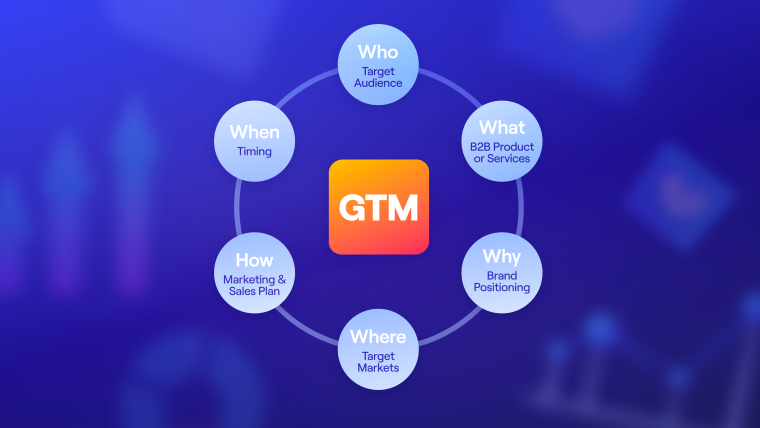
In the rapidly evolving landscape of Software as a Service (SaaS), establishing a robust go-to-market (GTM) strategy is imperative for achieving success. A well-designed GTM strategy enables SaaS companies to effectively introduce, sell, and deliver their products to customers.
Starting with all the research and planning that goes into developing a proper go-to-market strategy gives you a better chance at running a successful business. So many SaaS companies fail due to jumping in without taking these key steps.
This article will run through all the definitions and details surrounding what a go-to-market strategy is and isn’t, including a debriefing on the trendy new strategy – product-led growth. Then we’ll outline some steps to create your own GTM strategy, and give you a starting template to create one for your SaaS business.
Defining a Go-to-Market Strategy
A go-to-market strategy serves as a comprehensive plan for launching a product and winning over customers. It encompasses a few key aspects up front, including identifying the target market, determining pricing strategies, selecting distribution channels, and devising promotional activities. A well-executed GTM strategy aligns all efforts, facilitating optimal customer acquisition and revenue growth.
Go-to-Market Strategy for SaaS Companies
SaaS companies encounter unique challenges due to their subscription-based model and the necessity for continuous customer engagement. Consequently, a SaaS go-to-market strategy should concentrate on understanding the target audience, comprehending their pain points, and demonstrating how the software can enhance their lives. Additionally, pricing, customer onboarding, support, and continuous product improvement should be carefully addressed.
Importance of a Go-to-Market Strategy
There are a few reasons why a GTM strategy is so important, especially for SaaS businesses.
A go-to-market strategy provides valuable insights into the target market, including customer needs and competitor activities. This knowledge is crucial for positioning the SaaS product effectively. Going into business with this kind of market strategy in place gives you a much better shot at having a successful business moving forward. After all, 90% of startups fail, and you want to be on the other side of that statistic.
By formulating a GTM strategy, companies can allocate their resources judiciously, making informed decisions about where to invest in sales and marketing efforts. You’ll have a better idea of the exact tools you need, what your company size should be, and which key performance indicators you should be tracking.
A go-to-market strategy acts as a roadmap, ensuring all teams, including sales, marketing, and product, are synchronized and deliver a consistent customer experience. This makes it easier to keep everyone aligned around a core brand message and singular product development strategy. Your customers will thank you for your consistency and ability to deliver exactly what you’ve promised.
Go-to-Market Strategy vs. Marketing Strategy

While a marketing strategy primarily revolves around promoting products or services, encompassing branding, advertising, and lead generation, a go-to-market strategy takes a more focused approach. It outlines how the product will be introduced, sold, and delivered to the market, covering aspects such as pricing, distribution channels, and customer acquisition tactics.
A marketing strategy tends to evolve over time, using different marketing channels and campaigns to continually achieve a competitive advantage. The tactics and tools used will change seasonally and as new features are added to the product.
On the other hand, a go-to-market strategy should be in place before a product is launched, and remain the core strategy to attract customers for the lifetime of the product.
B2C vs. B2B GTM Strategy
B2C and B2B SaaS companies adopt different go-to-market strategies. B2C GTM strategies generally aim for mass-market appeal, user-friendly interfaces, and self-service options. In contrast, a B2B go-to-market strategy concentrates on building relationships, targeting specific industries, and demonstrating the value the software brings to businesses.
Types of Go-to-Market Strategies
There are three main types of go-to-market strategies you can consider:
Marketing-led Growth: This strategy places marketing at the forefront, driving customer acquisition and revenue growth. It involves utilizing various marketing channels, content marketing, lead generation campaigns, and targeted advertising to generate demand for the SaaS product.
Sales-led Growth: With this strategy, emphasis is placed on building a high-performing sales organization. The sales team becomes the driving force, identifying and engaging potential customers, conducting product demonstrations, negotiating contracts, and closing deals proficiently.
Product-led Growth: This strategy revolves around allowing the product to speak for itself. The focus is on delivering an exceptional user experience, offering free trials or freemium versions, and leveraging in-app analytics to guide users towards becoming paying customers.
Marketing-led Growth
Marketing-led growth centers on using marketing efforts to drive customer acquisition and revenue growth. To excel in this strategy, the following steps are recommended:
- Know Your Audience: Gain an in-depth understanding of the target audience, comprehending their motivations and how the SaaS product solves their problems.
- Create Compelling Content: Develop captivating content that educates and engages the audience, establishing trust and positioning the company as a thought leader.
- Leverage Multiple Channels: Harness the power of SEO, social media, targeted advertisements, content marketing and other inbound marketing tactics. There’s also email marketing, events, and trade shows to reach a wide range of potential customers.
- Nurture Leads: Implement effective lead generation and nurturing strategies to capture and qualify leads, guiding them through the buyer’s journey.
- Measure and Optimize: Continuously monitor marketing metrics, optimize campaigns, and enhance conversion rates through ongoing improvements.
Sales-led Growth
A sales-led growth strategy prioritizes the sales team. To implement this go-to-market strategy successfully, follow these steps:
- Define Your Target Market: Create an ideal customer profile (ICP) to focus sales efforts effectively.
- Build an Exceptional Sales Team: Assemble a high-performing sales team and equip them with the necessary tools and training to excel in their roles.
- Refine Your Sales Process: Develop a streamlined sales strategy that includes lead qualification, impressive product demonstrations, an effective pricing strategy, and successful deal closures.
- Cultivate Relationships: Establish strong relationships with key stakeholders and decision-makers, fostering trust and facilitating customer acquisition.
- Utilize CRM: Employ customer relationship management software to manage leads, track sales activities, and optimize the sales pipeline.
Product-led Growth
In a product-led growth strategy, the product takes center stage. To achieve success in this strategy, consider the following steps:
- Focus on Value: Develop a product that delivers exceptional value and effectively addresses the pain points of the target audience.
- Offer Free Trials: Allow users to experience the product’s benefits through free trials or freemium versions before committing to a purchase.
- Streamline Onboarding: Provide seamless onboarding experiences that enable users to easily get started and develop a strong affinity for the product.
- Analyze and Optimize: Utilize in-app analytics to gain insights into user behavior, identify areas for improvement, and continuously optimize the product.
- Expand and Upsell: Leverage product-led growth strategies such as referral programs, upselling, and cross-selling to encourage user expansion and drive revenue growth.
A SaaS Go-to-Market Strategy Template

To develop an exceptional SaaS go-to-market strategy, keep the following elements in mind:
Product-Market Fit
- Define your target market and identify their pain points, needs, and goals.
- Analyze the competitive landscape to understand the unique value proposition of your product.
- Conduct market research and gather feedback from potential customers to validate the fit between your product and the market.
- Continuously iterate and improve your product based on customer feedback to ensure it aligns with market demands.
Knowing Your Audience
- Create buyer personas to understand your target audience’s demographics, behaviors, motivations, and challenges.
- Identify the key decision-makers and influencers within the target organizations.
- Conduct customer interviews, surveys, and user testing to gain deeper insights into their needs and preferences.
- Use data analytics tools to analyze user behavior, engagement, and conversion metrics.
Choosing the Right Channels
- Identify the most effective channels to reach your target audience based on their preferences and behaviors.
- Consider channels such as content marketing, social media, search engine optimization (SEO), email marketing, partnerships, and events.
- Allocate your resources wisely by focusing on channels that have the highest potential for customer acquisition and retention.
- Continuously monitor and evaluate the performance of each channel and optimize your efforts accordingly.
Crafting Compelling Messaging
- Develop a clear and concise value proposition that highlights the unique benefits and competitive advantages of your product.
- Tailor your messaging to resonate with the pain points and aspirations of your target audience.
- Create compelling and engaging content that educates and informs your audience about the value your product provides.
- Use storytelling techniques to connect emotionally with your audience and differentiate your brand.
Pricing Things Correctly
- Determine the pricing model that aligns with your product’s value proposition and the market dynamics.
- Conduct pricing research to understand the willingness-to-pay of your target audience and the pricing strategies of your competitors.
- Consider factors such as the perceived value of your product, the costs involved, and the pricing elasticity of your niche market.
- Test different pricing tiers, packages, and promotions to find the optimal pricing strategy that maximizes revenue and customer satisfaction.
- Remember, this template should serve as a starting point, and you should tailor it to your specific SaaS product and target market. Regularly review and refine your strategy based on market feedback and evolving customer needs.
How Does SEO Fit Into a SaaS Go-To-Market Strategy?
A targeted SEO strategy is an excellent marketing channel to include as part of your GTM strategy. Whether you choose to work with a SaaS SEO agency, or build a team in-house, SEO will help you talk directly to your ideal customers with targeted keyword research and build brand authority through content marketing.
While SEO is a long-term strategy that provides sustainable results over time, it’s important to note that SEO is an ongoing process and requires continuous monitoring, analysis, and optimization. By integrating SEO into your SaaS go-to-market strategy, you can leverage the power of organic search to drive targeted traffic, increase brand visibility, and ultimately acquire more customers.

Brittney Fred, SEO Analyst
Brittney has been working in SEO and digital marketing for ten years and specializes in content strategy for the B2B SaaS industry. She is based in Denver, CO and absolutely fits the Denverite stereotype. You’re just as likely to find her hiking, snowboarding, or doing yoga as reading sci-fi or playing video games.
